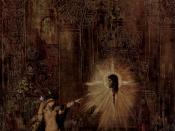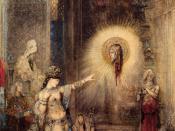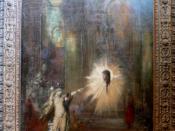a study about one of Moreau's famous painting, its symbols and the story behind this work of art.
Lobelle Grace Marfil
Art Appreciation
Prof. Christ
"The Apparition": by Gustave Moreau
Gustave Moreau was a French painter born in Paris, France, in 1826. Gustave Moreau is one of the first known symbolist artists. His art was about symbolic images based on myth and legend. Moreau style was focused on classical mythology and literature. The importance of mythical femme fatale, sphinxes, sirens, and other dangerous creature on his visionary style categorized Gustave Moreau as symbolist artist (loggia). Symbolist artist are artist that perform arts with themes like, death, spiritualism, evil, power or innocence.
One of Gustave Moreau symbolic famous work was, "The Apparition," a fascinating scene from the legend of Salome. Moreau used watercolor on this intriguing art; that was included in the Salon of 1876. In this painting, you will see a beautiful woman in the middle of the scene, by looking at her; you can tell that the story of this art focused on her.
The plot was in a cathedral; the architecture and the lightning are different. There are certain details used, such as the capitals inspired by the Alhambra in Grenada, Spain, and in the center the haloed statue, which, hardly visible in the watercolor, in the painting stands out against a bright background. Mainly influential is the evocation of temple caves in India, especially those at Elephanta, photographs of which Gustave Moreau had studied at the Palais de l'Industrie in 1873 (Horsley).
The Story:
Gustave Moreau, "The Apparition," had a story behind, like his other work of arts. The stunning woman in the middle is Salome, daughter of Herodias, which is in the left of the painting. Above of Herodias, are Herod, stepfather of Salome, and...


